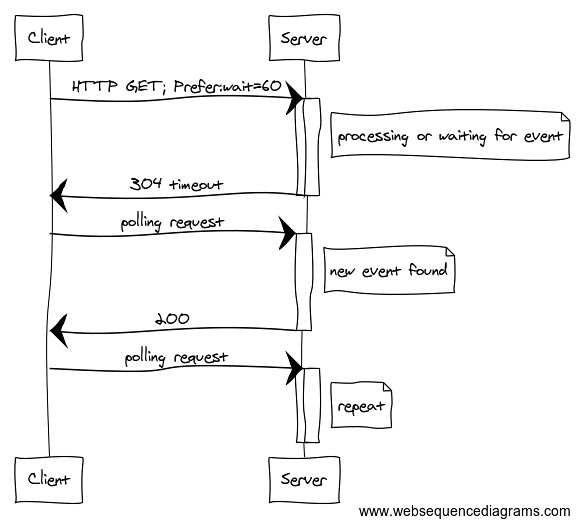Golang long-polling: a tale of server timeouts
I recently had a week long battle implementing HTTP long-polling. As so often happens in long debugging session in software development, my final fix was one line!
In modern web applications realtime live updates is becoming the norm. As such, I recently had the pleasure of implementing long-polling in one of my servers. There are a couple of ways a web app can get updates
- standard polling - where the web app makes a request on a standard interval, say, every second.
- long polling - the web app makes repeated requests but each request is long lived and changes are immediately pushed or the request times out and the app starts a new request
- http streaming - the web app makes a long lived request but the request is not closed and the server sends partial responses to the app as changes occur, using something like ndjson.
- web sockets - again the web app makes a single long lived request that allows bidirectional communication.
There are various reasons to choose any of the options 2 – 4, just never choose number 1! In out use case, we wanted to add read-only realtime to existing REST APIs, so long polling seemed like a natural and simple implementation.
Unfortunately, there doesn’t seem to be any standard or spec for long polling. This means “roll your own!” We settled on the follow request sequence
 Long Polling Sequence
Long Polling Sequence
Note that the polling timeout results in a 304 response. We also use the prefer header for sending the polling parameters
A very simple example that replicates this long polling sequence (but with GET parameters) looks like this
package main
import (
"context"
"fmt"
"io/ioutil"
"log"
"math/rand"
"net/http"
"net/http/httptest"
"time"
)
func getLongPollDuration(r *http.Request) time.Duration {
timeout, err := time.ParseDuration(r.URL.Query().Get("wait"))
if err != nil {
return 15 * time.Second
}
log.Printf("found custom timeout: %s", timeout)
return timeout
}
func getResource(ctx context.Context) string {
return "{\"id\": 1, \"updatedAt\": \"" + time.Now().Format(time.RFC3339) + "\"}"
}
func waitForResource(ctx context.Context, wait time.Duration) string {
// randomly wait up to 15 seconds for a "resource changed event"
r := rand.Intn(15)
ticker := time.Tick(time.Duration(r) * time.Second)
waiter := time.Tick(wait)
log.Printf("will wait up to %s for the resource", wait)
select {
case <-ctx.Done():
log.Printf("Received context cancel")
return ""
case ts := <-waiter:
log.Printf("Received method timeout: %s", ts)
return ""
case ts := <-ticker:
log.Printf("Received resource update at: %s", ts)
return "{\"id\": 1, \"updatedAt\": \"" + ts.Format(time.RFC3339) + "\"}"
}
}
func resourceFunc(w http.ResponseWriter, r *http.Request) {
index := r.URL.Query().Get("index")
if index != "" {
timeout := getLongPollDuration(r)
response := waitForResource(r.Context(), timeout)
if response == "" {
// write long poll timeout
w.WriteHeader(http.StatusNotModified)
}
fmt.Fprintf(w, response)
return
}
response := getResource(r.Context())
fmt.Fprintf(w, response)
}
func main() {
ts := httptest.NewServer(http.HandlerFunc(resourceFunc))
defer ts.Close()
// you should always set these timeouts, otherwise requests
// can never timeout
ts.Config.ReadTimeout = 10 * time.Second
ts.Config.WriteTimeout = 10 * time.Second
res, err := http.Get(ts.URL + "?index=2&wait=15s")
if err != nil {
log.Fatal(err)
}
resourceResp, err := ioutil.ReadAll(res.Body)
res.Body.Close()
if err != nil {
log.Fatal(err)
}
fmt.Printf("%s\n", res.Status)
fmt.Printf("%s", resourceResp)
}
You can run this at https://play.golang.org/p/kXMm-mE-tgl
My troubles, when implementing this and then exposing it with an nginx proxy was complicated by this line
ts.Config.WriteTimeout = 10 * time.Second
When we fist implemented the REST api, we set the default server timeouts to 10 seconds, but, when I started implementing the long polling, I set the minimum wait to 15 seconds. This results in sporadic 502 errors from nginx. Nginx was actually generating an error:
upstream prematurely closed connection while reading response header from upstream
Ultimately, the error message is correct and points to the exact issue (go
closing the request due to the timeout and then my handler trying to write to
it after it is closed), but the search results online were not super helpful.
Ultimately, it took me a little over a week of on-off debugging to track it
down to my own server config, doh! That WriteTimeout needs to be at least as
long as your maximum allowed long polling wait value, in our case 60s.
Hopefully, anyone else that runs into that same nginx error will now double check their own server timeouts too. Also, checkout this blog post by CloudFlare that goes into detail about the various go server timeouts